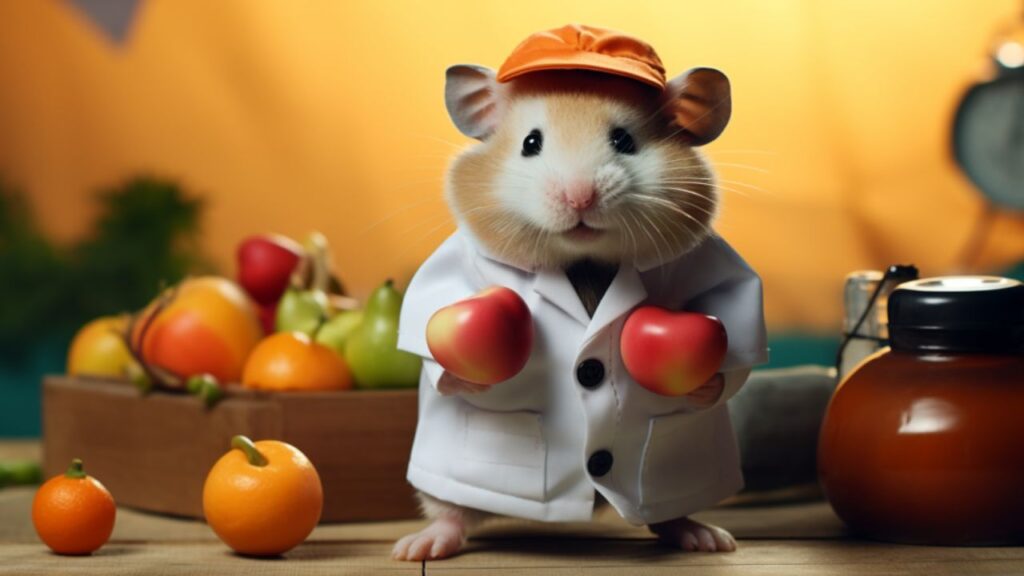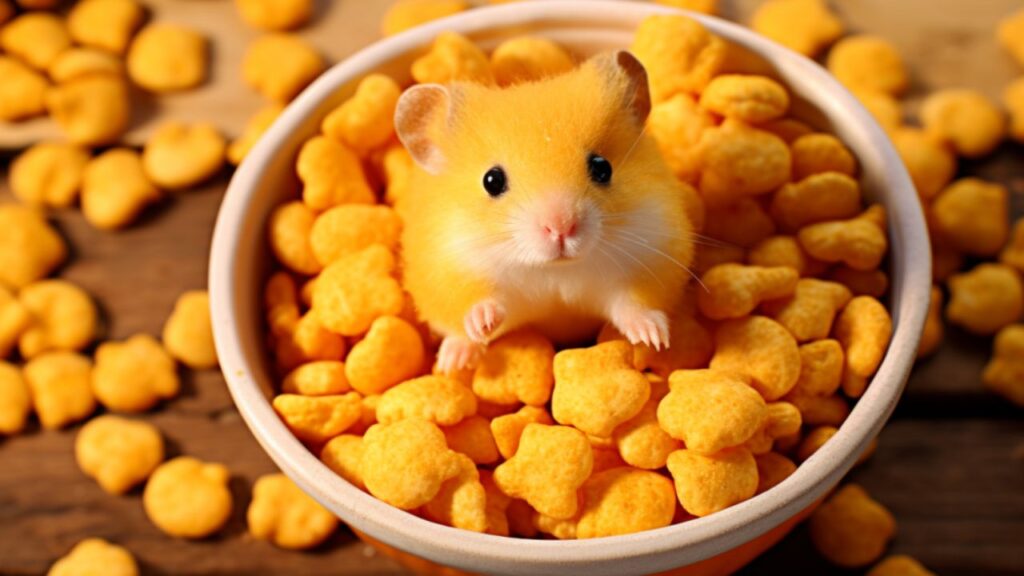TL;DR Summary
Hamsters can eat nectarines, but only in very small amounts and on rare occasions. The fruit must be fresh, free from pesticides, and thoroughly cleaned. Remove the skin and pit to prevent any health hazards. Nectarines contain beneficial vitamins and minerals but also have high sugar content, which can be harmful to hamsters if consumed in large quantities. Introduce nectarines to your hamster’s diet cautiously and monitor for any adverse reactions. Always prioritize a diet high in hamster pellets and vegetables, with fruits like nectarines as an occasional treat. Remember, moderation is key to keeping your hamster healthy and happy.
Embarking on the delightful yet complex journey of hamster nutrition, we encounter a particularly succulent query: Can hamsters have nectarines? This question isn’t simply about adding variety to a hamster’s diet; it’s about understanding the implications of introducing stone fruits to these tiny creatures. It’s a blend of curiosity and caution, a balanced inquiry into whether the luscious nectarine can fit into the dietary puzzle of a hamster’s life.
A Juicy Query: Can Hamsters Have Nectarines?
Nectarines, with their glossy skin and sweet flesh, can be tempting to share with our hamster pals. As pet owners, our natural inclination is to extend our own culinary delights to our pets. However, before passing a slice of this stone fruit to your furry friend, it’s essential to peel back the layers of nutritional wisdom to ensure it’s a safe and healthy choice for them.
The Stone Fruit Conundrum in Hamster Diets
The inclusion of stone fruits like nectarines in a hamster’s diet brings forth a spectrum of nutritional benefits and concerns. While they are replete with vitamins and antioxidants beneficial for humans, the suitability of their flesh, skin, and the ever-present hazard of the pit must be scrutinized carefully for the sake of our hamster’s health.
Setting the Scene for a Nutritional Exploration
As we set the stage for a comprehensive nutritional exploration, we’ll examine the nectarine in its full glory: its vibrant color hinting at beta-carotene presence, its juicy content a reservoir of hydration, and its sweetness, a dance of natural sugars. All these elements must be assessed with an understanding of a hamster’s dietary needs and restrictions to conclude whether nectarines can be part of their dietary repertoire.
Throughout this article, we will dissect the nectarine’s profile, balancing it against a hamster’s nutritional needs. We will take a vet’s-eye view on the advisability of this fruit as a treat, considering the proper serving size and preparation methods to avoid any dietary missteps. By the end of our exploration, hamster enthusiasts will be equipped with the knowledge to make informed decisions about feeding nectarines to their furry companions.
With the stage now set, let us delve deeper into the subject, ensuring every slice of information is served with clarity and purpose, just as we would serve a perfectly ripe piece of nectarine to ourselves—meticulously prepared and savored.
Understanding Hamsters’ Nutritional Framework

As we venture deeper into the dietary needs of these tiny, energetic creatures, it’s crucial to understand the framework of a hamster’s diet to appreciate how and where nectarines might fit.
A Peek into the Hamster Dietary Wheel
Hamsters are omnivores by nature, requiring a balanced wheel of nutrients that includes proteins, fats, carbohydrates, vitamins, and minerals. Their diet in the wild consists of a variety of seeds, grains, nuts, fresh vegetation, and the occasional insect or other proteins. Domesticated hamsters thrive on a similar diet, often supplemented with commercial hamster food that is formulated to meet their complex nutritional needs. Understanding this balance is essential; it’s not just about what hamsters can eat, but what they should eat to spin the wheel of their life with vigor and health.
Fruits in a Hamster’s Diet: How Sweet Can It Be?
Fruits, in moderation, can be a beneficial addition to a hamster’s diet, providing natural sugars, which are a source of energy, as well as essential vitamins and hydration. However, due to their high sugar content, fruits should only be offered as treats and not be a substantial part of a hamster’s daily intake. Overfeeding fruits can lead to obesity and diabetes. When considering fruits like nectarines, which are naturally sweet, moderation becomes an even more critical factor.
The Particular Place of Stone Fruits Like Nectarines
Stone fruits, such as nectarines, come with their own set of considerations due to the presence of pits, which can be a choking hazard, and the potential for toxic substances. While the flesh of a nectarine can be packed with nutrients, it is paramount to understand the correct serving size and preparation to avoid any risk. Additionally, stone fruits contain more sugar than some other fruits, and their acidity can sometimes cause digestive issues in hamsters. It’s a delicate balance to strike, ensuring the treat is both safe and health-supporting.
In the grand scheme of a hamster’s diet, nectarines and other stone fruits must be introduced thoughtfully, with consideration of their sugar content and potential risks. As we peel away the layers of nutritional facts, the role of nectarines in a hamster’s diet will become clearer, helping us decide if they are an appropriate indulgence for our furry friends.
Nectarines Demystified: Nutritional Profile

Diving into the juicy world of nectarines, it’s important to dissect the nutritional profile of this succulent fruit to understand its potential place in a hamster’s diet.
The Sweet Spot: Vitamins and Minerals in Nectarines
Nectarines are a nutritional powerhouse when it comes to their vitamin and mineral content. They boast a wealth of Vitamin C, which is crucial for the repair of tissues and enzymatic production of certain neurotransmitters. Also present are Vitamin A for eye health, and dietary fiber for digestive regularity. Moreover, nectarines are a source of potassium, necessary for maintaining fluid balance and nerve function, and antioxidants that help fight against free radicals in the body. For a hamster, these nutrients can support overall health when introduced in the right amounts.
Sugar Content in Nectarines: A Double-Edged Sword?
While the sweet taste of nectarines can make them an alluring treat for hamsters, their sugar content needs to be addressed with caution. High sugar intake can lead to obesity and diabetes in hamsters, just as it can in humans. Nectarines contain natural sugars, such as fructose, which while healthier than refined sugar, still need to be offered in moderation. For hamsters, whose tiny bodies process sugars quickly, the risk of overconsumption is high, turning the sweet treat into a potential health hazard.
The Pitfall: Risks of Stone Fruits for Hamsters
The potential risks associated with stone fruits like nectarines cannot be ignored. The pits not only pose a choking hazard but also contain amygdalin, which can convert into cyanide when ingested and can be toxic. There’s also the matter of the fruit’s skin, which, if treated with pesticides, can be harmful to hamsters. Organic, thoroughly washed nectarine slices without the pit and skin can mitigate these risks, but the dangers highlight the need for careful preparation and consideration before offering this fruit to a hamster.
As we examine the nectarine’s nutritional profile, it’s evident that while they can be a source of valuable nutrients for hamsters, they also come with significant risks that must be carefully managed. Ensuring that nectarines are served in a hamster-friendly way is essential to reaping the benefits while avoiding the pitfalls of this otherwise healthy fruit.
Feeding Nectarines to Hamsters: A Guided Approach

The inclusion of nectarines in a hamster’s diet requires a guided approach to ensure their well-being. Below, we delve into the dos and don’ts of serving size and frequency, the safe preparation of nectarines, and how to recognize potential allergic reactions.
The Dos and Don’ts: Serving Size and Frequency
When introducing nectarines or any new food into your hamster’s diet, it’s vital to do so gradually and in small quantities. A tiny cube of nectarine—no larger than a cubic centimeter—once a week is sufficient for a hamster. This controlled portion minimizes the risk of digestive upset and prevents the sugar in the fruit from becoming a health issue. Consistency and moderation are key; offering nectarines too frequently can lead to health problems, including diabetes and obesity, due to their high natural sugar content.
Preparing Nectarines for Your Hamster: Safety First
Safety in preparation is paramount when it comes to feeding nectarines to hamsters. Start with a ripe, organic nectarine to avoid pesticide exposure. Wash the fruit thoroughly, peel off the skin, and ensure you remove the pit and any hard parts that could pose a choking hazard or contain harmful substances. The nectarine should be cut into small, manageable pieces that your hamster can easily chew and digest. Offering the fruit fresh, without any additives or sugars, preserves the nutritional benefits and prevents potential health issues.
Allergic Reactions and Signs to Watch For
While allergic reactions to nectarines in hamsters are not commonly reported, it’s important to observe your pet closely after introducing any new food. Signs of an allergic reaction may include excessive scratching, swelling around the mouth or face, changes in breathing, or gastrointestinal distress such as diarrhea. If you notice any unusual behavior or symptoms after your hamster has eaten a nectarine, it’s essential to discontinue feeding the fruit immediately and consult with a veterinarian for advice.
By following these guidelines, you can offer nectarines to your hamster in a way that is both safe and potentially beneficial. It’s all about finding the right balance to maintain the health and happiness of your furry companion.
The Benefits and Risks of Nectarines in a Hamster’s Diet

Incorporating nectarines into a hamster’s meal plan can offer both nutritional perks and certain risks. Here we explore when nectarines can be a healthy treat and when they might pose potential health implications for these small pets.
A Bite of Benefit: When Nectarines Can Be Good
Nectarines can be a good source of hydration and contain several beneficial nutrients that may contribute to a hamster’s health. They are rich in vitamins A and C, which are important for maintaining good vision, skin health, and immune function. They also provide dietary fiber, which can aid in digestion.
When offered in moderation, a well-ripened nectarine can serve as an occasional treat that adds variety to a hamster’s diet. The natural sweetness of the fruit can be a delightful change for your pet, stimulating their palate and encouraging foraging behaviors.
A Slice of Caution: Potential Health Implications
Despite their benefits, nectarines must be given with caution due to their sugar content and potential toxicity of their pits. The sugar in nectarines can contribute to obesity and diabetes if fed in large amounts or too frequently. It is critical to ensure that the nectarine is seedless before serving it to your hamster, as the pits contain traces of cyanide which is toxic to small mammals.
The fiber in nectarines, while generally healthy, can cause digestive upset in hamsters if they are not used to it. It’s important to introduce this fruit slowly into their diet to monitor how they react to it. Too much fiber can lead to diarrhea, which can quickly dehydrate a small hamster.
Finally, there’s a risk of overfeeding, which can displace essential nutrients in the hamster’s diet if they consume too much fruit and neglect their regular, balanced meals. A hamster’s diet should be primarily composed of high-quality hamster pellets, with treats like nectarines being just a small part of their overall intake.
In summary, nectarines can be a healthy and enjoyable treat for hamsters when given appropriately. It’s crucial to weigh the benefits against the risks and to consult with a veterinarian if you’re unsure about the best way to incorporate this stone fruit into your hamster’s diet.
Whisker Tips: Introducing Nectarines to Your Hamster

Introducing a new food to your hamster’s diet should always be done with care and consideration. With nectarines, there are a few Whisker Tips to keep in mind to ensure you are providing the safest and most enjoyable experience for your furry friend.
Selecting the Safest Nectarines for Your Pet
When picking out nectarines for your hamster, always opt for organic fruit to avoid pesticide exposure. Ensure the fruit is ripe but not overly so, as overripe nectarines can be too sugary and mushy for hamsters to handle well. Thoroughly wash the fruit to remove any traces of chemicals or dirt from the surface.
The Ideal Serving: Making Nectarines a Special Treat
Nectarines should be a rare treat, not a staple of your hamster’s diet. A small slice or a couple of tiny cubes equivalent to the size of your hamster’s paw is more than enough. Remove any pits and seeds to prevent any risk of cyanide poisoning, and offer this treat no more than once a week to avoid issues related to overconsumption of sugar and fruit acid.
Monitoring and Understanding Your Hamster’s Reactions
After giving your hamster nectarines for the first time, observe their reaction closely. Look for signs of enjoyment, such as eager eating or pouching, but also be vigilant for any adverse reactions. Diarrhea, changes in energy levels, or signs of discomfort could indicate that your hamster is not handling the new treat well. If you notice any negative reactions, discontinue feeding nectarines and consult your veterinarian.
Remember to introduce nectarines gradually, starting with a tiny amount to allow your hamster’s digestive system to adjust. Always return to a baseline diet of pellets, fresh water, and an occasional veggie after treating your pet, and watch for any changes in their stool or behavior. With these Whisker Tips, you can safely introduce the sweet, juicy delight of nectarines into your hamster’s world.
Viable Alternatives to Nectarines for Hamsters

While nectarines can be a delightful treat for hamsters when given in moderation, it’s essential to have a variety of alternatives to ensure a balanced and nutritious diet. Let’s explore some viable options that can provide safe sweetness and essential nutrients.
Seeking Safer Sweetness: Fruit Alternatives
Fruits should always be offered sparingly due to their sugar content, but some are safer than others for your hamster. Blueberries, for instance, are packed with antioxidants and can be given in small quantities. Apples (without seeds and core) and pears are also suitable when served in tiny, bite-sized pieces. Melon and strawberries can be refreshing during the warmer months but should be given less frequently due to their higher sugar content.
Nutrient-Rich Substitutes: Beyond Just Sweetness
For a well-rounded diet, hamsters benefit from more than just the occasional fruit treat. Vegetables can be a great source of vitamins and are generally lower in sugar. Broccoli, spinach, and peas can be offered for their nutrient content, fiber, and to add variety to your hamster’s diet. Cooked plain pumpkin or carrots provide beta-carotene and other essential nutrients, making them excellent occasional treats.
Always ensure that any fruit or vegetable you introduce is free of pesticides and chopped into manageable, bite-sized pieces to prevent choking hazards. Gradual introduction is key to monitor for any digestive upsets or food preferences, and always remove any uneaten fresh food before it spoils.
By considering these alternatives, you provide your hamster with a diet that is both nutritious and enjoyable. Offering a variety of fruits and vegetables not only enriches your hamster’s nutritional intake but also adds enrichment to their daily life through new flavors and textures. Remember to tailor these offerings to your hamster’s individual needs and dietary tolerances, and when in doubt, consult with a veterinarian familiar with small pets.
Final Thoughts on Nectarines and Hamster Health

As we wrap up our exploration of whether hamsters can safely indulge in nectarines, it’s important to balance the scales of dietary needs and potential treats. We’ve peeled back the layers of nutritional facts and cautions, providing a comprehensive guide for hamster owners who wish to diversify their pet’s diet with the inclusion of stone fruits.
The Nectarine Narrative: Balancing the Scale
Nectarines, like all fruits, should be given to hamsters in moderation. While they offer vitamins and can add variety to your hamster’s diet, the sugar content and potential risks of the stone and skin mean they should be a rare treat rather than a dietary staple. Ensuring that your hamster has a diet primarily composed of high-quality hamster pellets, a variety of vegetables, and occasional fruits, will promote a healthy, balanced diet.
Personalizing Your Hamster’s Fruit Intake
Every hamster is an individual, with specific tastes and digestive capabilities. Some may tolerate nectarines well, while others may not. It’s critical to observe how your hamster reacts to new foods and adjust their diet accordingly. Introducing any new food, including nectarines, should be done slowly and with close observation for any adverse reactions.
Signature Closing: Remember, a happy hamster is a wheel-y happy you!
To ensure your furry friend remains in top wheel-running shape, always prioritize a diet that’s suitable for their delicate digestive system, provides the necessary nutrients, and offers the joy of variety without the risk of harm. By following these guidelines and consulting with your vet when needed, you’ll keep your hamster’s cheek pouches and health in peak condition. Remember, a balanced diet makes for a contented hamster and, in turn, a wheel-y happy you!




